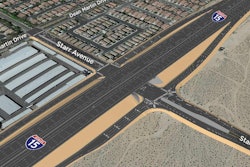 Photo: Maine Department of Transportation
Photo: Maine Department of TransportationEngineers believe the $158.5 million Sarah Mildred Long Bridge project, connecting Portsmouth, N.H., with Kittery, Maine, may be the first vertical-lift bridge to use precast-concrete segmental towers, the Engineering News-Record reports. Construction of the new bridge carrying U.S. Route 1 Bypass over the Piscataqua River began in 2015. The bridge is slated to open by the end of 2017 and be completed by June 2018. The project is a joint venture between the Maine Department of Transportation (MaineDOT) and New Hampshire Department of Transportation, with MaineDOT serving as the owner.
According to the news agency, Mike Hawkins, project manager with Hardesty & Hanover, said the structural-steel, twin box-girder lift span carries one lane of traffic in each direction, with railroad tracks down the middle. To accommodate two railroad crossings to the Portsmouth Naval Shipyard every year, the bridge track structure will rise 2 feet, the bearings supporting the bridge in its roadway position will rotate 90 degrees, and the bridge will lower about 50 feet to the railway position. “The bridge will primarily spend time in the roadway-seated position and raise up like a normal lift bridge to allow for marine traffic to clear underneath,” Hawkins said.
Hardesty & Hanover designed the precast towers, Figg Bridge Group designed the precast superstructure for the approach bridges, and Cianbro designed the partially submerged precast tower footing tubs to support 10-foot-diameter shafts. The concrete segmental approaches and the steel twin box-girder lift span were delivered to the site from off-site vendors.
“Six steel box-girders were delivered by barge on six loads from south Portland, Maine,” Kaven Philbrook, project manager for Cianbro, told the news agency. “Unlike other projects where bridge spans are erected off site, the 300-foot by 50-foot lift span was erected on a barge to float in place during a channel closure.”
The 88 tower segments were precast on site and erected in post-tension. “We purchased a [specialty] precast form from Italy for casting segments we loaded on barges and took out to erect the towers. That’s a first,” Philbrook told the news agency.
Hardesty & Hanover also designed tower piers that sustain vessel impact without a large, separate fender system. “High-density absorbing [rubber] arch fenders are directly attached to the bridge tower piers for added protection,” Hawkins told the news agency.













